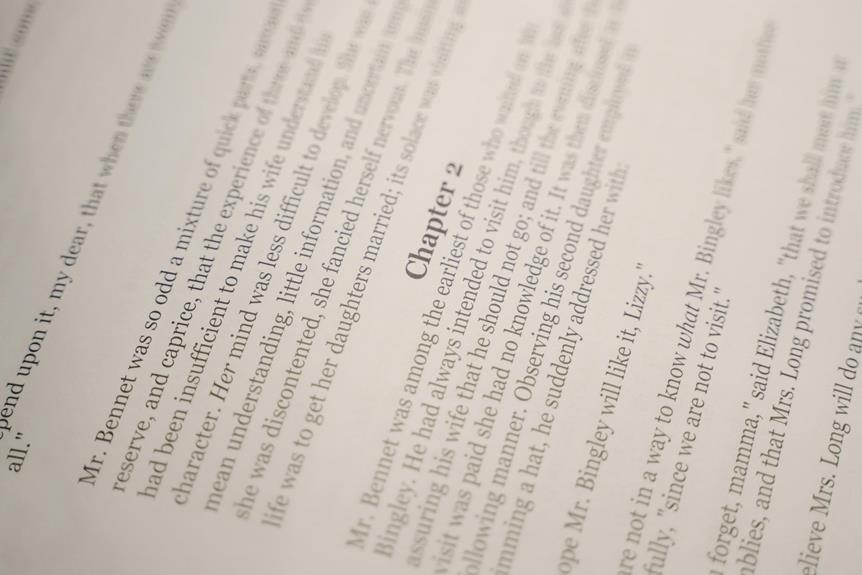As you navigate through the intricate tapestry of Chapter 80, be prepared to encounter semantic pitfalls lurking beneath the surface. Ambiguous word choices may lead you astray, while confusing phrasing could cloud your understanding. Keep a keen eye out for inconsistencies in language use that might disrupt the narrative flow.
Misinterpretations caused by errors could distort the intended message, leaving you to unravel hidden meanings shrouded within the text. Stay vigilant as you explore Chapter 80; the semantic landscape is ripe with potential discoveries.
Ambiguous Word Choices
In Chapter 80, watch out for ambiguous word choices that might confuse readers and detract from the clarity of your writing. Ambiguity occurs when a word or phrase has more than one possible meaning, leading to confusion or misinterpretation. To prevent this issue, strive for precision in your language. Instead of using vague terms, opt for specific and concrete words that leave no room for misunderstanding.
When revising your work, pay close attention to words with multiple interpretations. For example, words like 'set,' 'run,' or 'put' can have various meanings depending on the context. Be mindful of these potential pitfalls and choose words that convey your intended message clearly.
Additionally, consider the perspective of your readers. What might be clear to you as the writer could be puzzling to someone unfamiliar with the subject matter. Put yourself in their shoes and ensure that your word choices make sense in the given context. By being vigilant and deliberate in your selection of words, you can enhance the overall clarity and effectiveness of your writing in Chapter 80.
Confusing Phrasing
Watch out for phrasing in Chapter 80 that may confuse readers and hinder the clarity of your writing. When constructing sentences, be cautious of using overly complex structures or convoluted language that could obscure your intended message. Keep your phrasing straightforward and direct to ensure that readers can easily follow your train of thought.
Avoid using excessive adjectives or adverbs that may clutter your sentences and lead to confusion. Instead, opt for precise and concise language that conveys your ideas efficiently. Additionally, be mindful of using jargon or technical terms without providing sufficient context for readers to understand their meaning.
Another common pitfall to watch out for is ambiguous pronoun references. Make sure that pronouns like 'it,' 'this,' or 'that' clearly refer to a specific antecedent to prevent confusion about what they represent.
Inconsistent Language Use
Ensure your writing maintains consistency in language use to avoid confusing your readers and maintain coherence throughout Chapter 80. Inconsistencies in language can disrupt the flow of your narrative, making it harder for your audience to follow along smoothly.
One common issue to watch out for is switching between formal and informal language. If you start off using a formal tone, make sure to stick with it throughout the chapter. Similarly, if you choose to use contractions and a more casual style, maintain that approach consistently.
Another aspect to consider is the use of specific terminology or jargon. If you introduce certain terms or phrases at the beginning of Chapter 80, be sure to continue using them in a consistent manner. Changing terminologies midway can lead to confusion and hinder the reader's understanding.
Additionally, pay attention to the tone of your writing. Whether it's serious, lighthearted, or informative, maintaining a consistent tone can help create a cohesive reading experience for your audience.
Misinterpretations Caused by Errors
Maintaining consistency in your language use throughout Chapter 80 can prevent misinterpretations caused by errors, ensuring a smoother reading experience for your audience. When you switch between different terms or use ambiguous phrases, readers may struggle to follow your intended meaning. For example, if a character is referred to by their full name in one paragraph and then by a nickname in another, confusion can arise. These inconsistencies can lead to misunderstandings and disrupt the flow of the narrative.
Additionally, errors in pronoun reference can create confusion for readers. If pronouns such as 'he,' 'she,' or 'they' are unclear or don't clearly refer to the intended antecedent, readers may have to backtrack to decipher the correct meaning. This back-and-forth disrupts the reading experience and can detract from the overall enjoyment of the chapter.
Uncovering Hidden Meanings
To fully grasp the depth of Chapter 80, delve into the text to uncover its hidden meanings. As you navigate through the words on the page, be attentive to subtle nuances and underlying themes that may not be immediately apparent. Authors often embed deeper layers of significance that require a closer examination to reveal.
Pay attention to recurring symbols, metaphors, or motifs that could offer insights into the author's intended message.
Keep in mind that interpretations can vary among readers, so trust your instincts and personal analysis when uncovering these hidden meanings. Look beyond the surface level of the text and consider how different elements interact to convey a more profound understanding of the narrative. Engaging with the material on a deeper level can lead to a richer and more fulfilling reading experience.
Frequently Asked Questions
How Does Chapter 80 Contribute to the Overall Theme of the Novel?
Chapter 80 contributes significantly to the novel's theme by highlighting key character developments and plot resolutions. The chapter unfolds crucial events that tie together loose ends, providing clarity and depth to the overarching narrative.
Are There Any Historical or Cultural References in Chapter 80 That Readers Should Be Aware Of?
In Chapter 80, historical and cultural references enrich the narrative, offering insights into the characters' backgrounds and motivations. Being aware of these references enhances your understanding of the story's context and the characters' actions.
What Is the Significance of the Setting in Chapter 80?
The setting in Chapter 80 holds great significance as it sets the tone and atmosphere for crucial events. Pay attention to details like lighting and surroundings to fully immerse yourself in the story.
How Does the Character Development in Chapter 80 Impact the Rest of the Story?
In Chapter 80, character development plays a crucial role in shaping the rest of the story. You'll notice how the actions and decisions of the characters influence the plot, creating a ripple effect throughout the narrative.
Are There Any Symbols or Motifs in Chapter 80 That Readers Should Pay Attention To?
In Chapter 80, you should pay attention to the recurring motif of the red scarf symbolizing love and sacrifice. It's a subtle but powerful symbol that adds depth to the characters' interactions and the overall narrative.
Conclusion
In conclusion, Chapter 80 may contain semantic errors such as ambiguous word choices, confusing phrasing, inconsistent language use, and misinterpretations caused by errors.
By being aware of these potential pitfalls, readers can better navigate the text and uncover any hidden meanings that may be lurking within.
Stay vigilant and attentive to detail as you delve into Chapter 80 to fully grasp the intended message.








